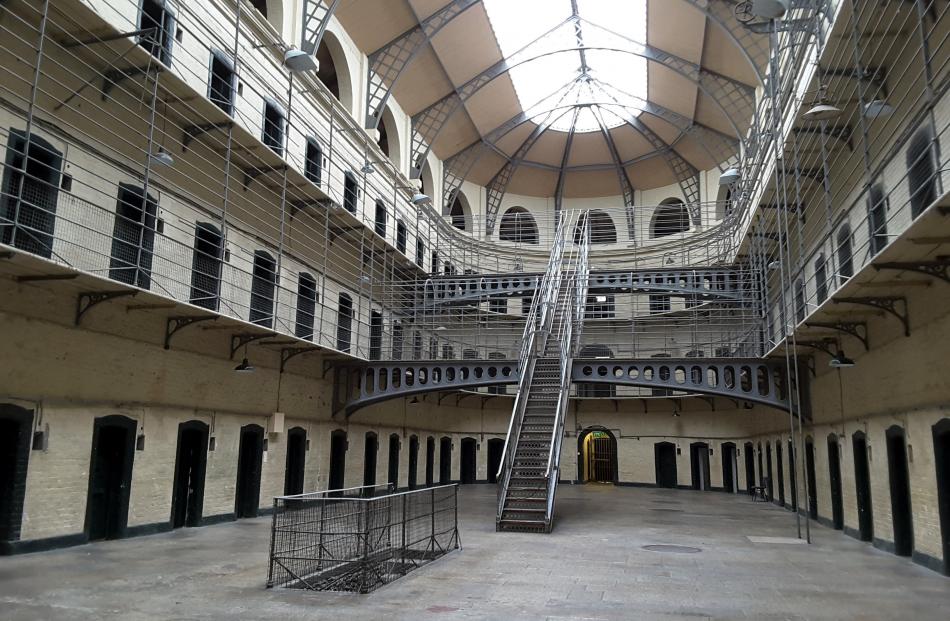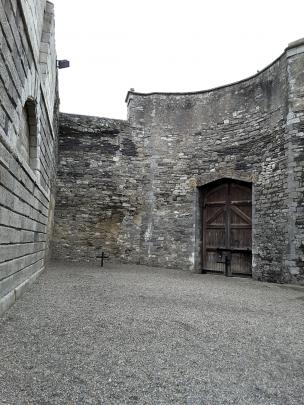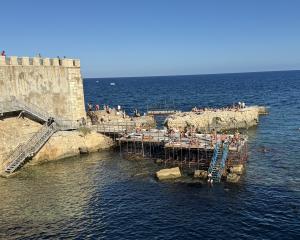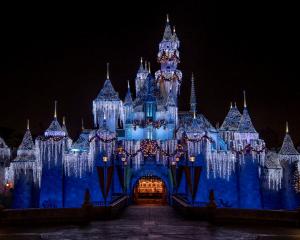Dunedin writer Tony Eyre travelled back to 1916 on a short visit to Dublin.
Dublin is in flames. Revolution is spilling on to the streets and little did I expect to be running stealthily through St Stephen's Green with Chrissie, delivering her message to the leaders of the Irish Citizen Army during their dug-in occupation of the square. Nor did I expect to be confronted by an armed British soldier roaring at us - much to the consternation of lunchtime passersby - as we paused to catch our breath in the elegant lakeside bandstand.
As I snuck away, the nearby lake gently rippled to the movement of its resident ducks. In 1916, while fierce gunfire raged all week between Irish and British troops near this same spot, a bizarre ritual took place. Each day a ceasefire was called so the park's caretaker could wander down to feed the large population of ducks.
So this was the 1916 Easter Rising, Ireland's bloody six-day armed insurrection by Irish republicans against British rule and the focus of centenary commemorations this year to mark a seminal event in history that sowed the seeds for the eventual establishment of an independent Irish Republic.
And that explains why I was caught up in an interactive theatrical experience on board a specially designed bus, enthralled by the stunning performance of actors bringing to life the personal stories of those in the Easter Rising as we visited key sights of the 1916 rebellion. This attraction called ``The 1916 Tour - Beyond Barricades'' was one of a handful of commemorative events that I chose on my short 2016 visit to Dublin to give me an insight into this centenary programme with its noble themes of remembering, reconciling, imagining and celebrating.
I was not able to be in Dublin over Easter weekend when more than one million attended the Easter Sunday Parade and other public events but there was still plenty to see when I popped across the Irish Sea from London's Gatwick Airport.
Wynn's Hotel in Lower Abby St was my choice of stay. This traditional house of hospitality dates back to 1845 in its various forms. On the afternoon of my arrival the lift in the lobby had taken a day off but with the help of a back-of-house service lift and armed with my room key attached to its heavy brass knocker, I settled into my fourth-floor room complete with original open fireplace. In a state of delusion, I made myself at home in the Saints and Scholars bar downstairs for a Guinness pick-me-up and beef sandwiches.
The hotel has strong and fiery connections with the 1916 Easter Rising. A plaque in the bar commemorates a meeting in the hotel in 1913 at which a decision was made to establish the Irish Volunteers, a military force that would play a prominent role in the Easter Rising. And where there's smoke there's fire. Under British military bombardment, a barricade outside Wynn's Hotel burst into flames and spread to the timber facings of the hotel, burning it to the ground. The current hotel in which I was staying was built in 1926 and was used as a location in the 1996 movie Michael Collins.
Around the corner from my lodgings was the Ambassador Theatre in O'Connell St featuring the centenary exhibition ``Revolution-1916''. More than 500 artefacts from private collections were on display, including an original Proclamation of the Irish Republic, the legendary document of independence.
A highlight of the exhibition was the profiles of many women who took part in the Easter Rising but whose stories had not been fully told until recently. Among those featured was the well-known Countess Constance Markievicz, prominent in the revolution leadership, Abbey Theatre actress and suffragette Helena Molony, who took part in the attacks on Dublin Castle and City Hall, and the nurse and activist Elizabeth O'Farrell, who risked her life delivering the surrender message of the rebels to the British Command.
Vastly outnumbered, the rebels' Easter Rising was over within six days. Retribution was swift and deadly. Over a period of two weeks all seven signatories to the Proclamation and seven others were executed by firing squad at Kilmainham Gaol. Hundreds of others were deported to prisons and internment camps.
Making use of Dublin's popular Hop On Hop Off bus, I was keen to take a guided tour of the jail whose grim walls have incarcerated and executed many leaders of the Irish rebellions from 1798 right through to 1916. It is now a heritage museum. Bookings are recommended as there is a maximum of 35 people per tour.
The East Wing, with its Victorian ``panoptic design'', speaks menacingly of institutional power as you gaze up to its three storeys of cells, metal catwalks, stairwells and enormous skylight. As soon as you are led into Kilmainham's older West Wing with its dark narrow corridors of grey flagstones and peeling lime wash, the jail's grim and disturbing history is palpable. The ``Red Chapel'' in the Central Block provides some relief. But it was here that Grace Gifford married Joseph Plunkett, one of the Proclamation signatories, the night before he was executed. She was taken back to the prison a few hours later at 2am to say her final farewell to her new husband.
Climbing to the upper levels of the West Wing, we passed cell after cell with their solid padlocked doors, each with a spy hole to observe each inmate's cold and dimly lit prison. I entered the cell of Robert Emmet, the leader of the abortive 1803 rebellion against British rule. He spent his last night here before being hanged and beheaded. Other cell doors bear the names of some of the 1916 Easter Rising leaders - Thomas Clarke, Eamon de Valera and Padraig Pearce (and his younger brother Willie). With the exception of de Valera, the fate of these Irish revolutionaries was to be decided in the Stonebreakers' Yard.
What struck me first as I walked into this enclosed prison yard were the towering walls open to the sky and the silhouette of a small black cross in one corner - a spot, some would argue changed the course of Irish history. Here 13 of the condemned men were shot at daybreak by firing squad. The 14th and last to be executed was James Connolly. Severely wounded, he was carried into the Stonebreakers' Yard on a stretcher, tied to a chair and shot.
Previously, the Irish public, the newspapers and the Catholic Church were largely unsympathetic to the rebel cause. It was not surprising given that large parts of Dublin lay in ruins after the Easter Rising and in the same week over 500 Irish soldiers in the British Army were killed by German gas attacks in the trenches of Hulluch in northern France. But following the executions in Kilmainham Gaol public opinion shifted and the Easter Rising leaders were elevated to martyrs and heroes. The flame of freedom had been rekindled.
Dublin's General Post Office takes centre stage in O'Connell St, formerly known as Sackville St. The grandeur of its Greek neoclassical design with the Irish Tricolour flag proudly flying on its crest makes this public building a popular icon on the main street and still serves its purpose as the main post office for the city. But it is its role in the 1916 Easter Rising that has made it an enduring symbol of Irish independence.
On Easter Monday 1916, a group of rebels stormed the GPO and took command of the building and it was here that Padraig Pearse read aloud the Proclamation of an Irish Republic signed by the seven members of the so-called Provisional Government. The garrison established here soon came under heavy fire. Incendiary shelling by the British later in the week left the GPO a hollow shell in smoking ruins.
Of today's rebuilt GPO, only the front facade and portico with its six columns remain from the destroyed original. It's worth a visit if just to see its grand interior (or buy a stamp) but with my Easter Rising focus I headed into the newly opened ``GPO Witness History'' centre, a permanent interactive exhibition where you can experience the events of 1916 from both sides of the conflict. Designed to capture the attention of young people, a huge semicircular cinema screen features a 3-D animated video that shows dizzying bird's-eye views of the fighting that took place around the GPO. And as a tribute for each of the children killed during Easter week, a permanent artwork of 40 tiny limestones on a mirrored steel surface has been installed in the GPO courtyard.
In the rising's headquarters in the GPO, the ``big fellah'' Michael Collins fought alongside its rebellion leaders but it was from the vacuum created by the executions that he emerged as a major figure in the events to follow - the Irish War of Independence against British rule and the tragic Civil War between pro- and anti-treaty factions. To round off my visits to Easter Rising events, I took the Luas tram to Collins Barracks, now a branch of the National Museum of Ireland. This vast former military complex, previously called the Royal Barracks was renamed when the Irish Free State came into being in 1922, the same year that Collins was ambushed and killed. As I stood dwarfed in Clarke's Square that had housed thousands of troops for over three centuries, it wasn't hard to imagine the sounds of the fife and drum, drill parade and the clatter of hooves.
But I was here to see another exhibition to mark the centenary commemorations and with time running out, it was the ephemera and items of historical significance that caught my eye. Displayed here was one of the original tattered republican flags hoisted up the GPO flagpole in Sackville St; an unvarnished dining table on which the proofs of the Proclamation had been laid out and my favourite ``the cricket bat that died for Ireland''.
Lying in state after rescue from a sporting goods store, the bat has a British .303 bullet lodged in its blade.
The hundreds of objects on display like this English cricket bat (ironically not an Irish hurley stick) each in their own small way bear silent witness to the much larger narrative that is the Easter Rising of 1916. George Bernard Shaw called it a quixotic failure but out of that violence, grief and tragedy, a sovereign independent nation was born. And for the hundreds of thousands who turned out to witness the ceremonies at the GPO on Easter Sunday 2016, that was indeed worth celebrating.
Tony Eyre is a Dunedin writer who spent time in Dublin with some assistance from Tourism Ireland.




















